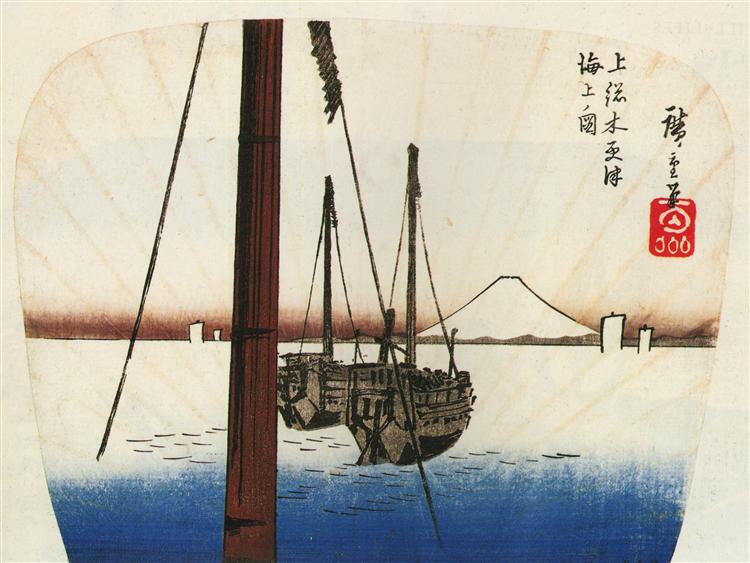Description
Utagawa Hiroshige's painting "Mount Fuji Seen Through Water" (1857) is a fascinating depiction of the iconic Japanese mountain, a recurring and revered subject in Japanese art. Hiroshige, one of the foremost exponents of ukiyo-e, uses this work to explore the relationship between landscape and nature, a theme that permeates his work and often reflects a unique sensitivity to the environment and human experience.
The composition of the painting is a play of natural and aquatic elements that intertwine with the monumental figure of Fuji. In the foreground, calm waters flow, gently reflecting the mount that rises majestically on the horizon. This use of water as a mirror not only provides a deep sense of calming serenity, but also establishes a symbolic connection between earth and sky. Hiroshige has stripped away superfluous details, focusing on the simplicity of the landscape, inviting the viewer to lose themselves in the immensity of the view.
The colour palette is equally striking; Hiroshige uses delicate shades of blue, grey and white that intermingle to produce an atmospheric effect that emphasises the serenity of the setting. Mount Fuji is rendered in soft tones, fading from a deep blue at the bottom to an almost ethereal white at the top, accentuating its grandeur and almost mythical character. This attention to colour not only reflects technical mastery, but also creates a sense of harmony and balance.
Throughout his career, Hiroshige was noted for his ability to capture the essence of the seasons and the passage of time. In Mount Fuji Seen Through Water, the wind seems to caress the water, and the tranquility of the landscape is almost palpable. Although the work does not feature human characters in the foreground, the absence of figures is a deliberate choice that emphasizes the immensity of nature and allows the viewer to reflect on their own existence in relation to the environment.
Hiroshige, active during the Edo period, was a key figure in the development of Japanese landscape art, and his work has inspired generations of artists both in Japan and the Western world. Mount Fuji Seen Through Water is a clear example of his ability to depict not only the form but also the emotional atmosphere of a place. This work is part of his series “The Fifty-Three Stations of the Tōkaidō,” which captures various views and experiences along the journey between Edo (present-day Tokyo) and Kyoto.
Through his distinctive style, Hiroshige manages to infuse a profound poetry into his depiction of the landscape. Nature is transformed into a space where the viewer can meditate on the ephemeral beauty of life and the permanence of the mountain. “Mount Fuji Seen Through Water” is not only a masterpiece of ukiyo-e, but also an invitation to reflect on our relationship with nature, an endless cycle that continues to resonate to this day.
KUADROS ©, a famous painting on your wall.
Hand-made oil painting reproductions, with the quality of professional artists and the distinctive seal of KUADROS ©.
Painting reproduction service with satisfaction guarantee. If you are not completely satisfied with the replica of your painting, we will refund 100% of your money.

